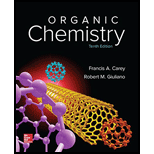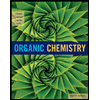
Organic Chemistry - Standalone book
10th Edition
ISBN: 9780073511214
Author: Francis A Carey Dr., Robert M. Giuliano
Publisher: McGraw-Hill Education
expand_more
expand_more
format_list_bulleted
Concept explainers
Textbook Question
Chapter 3, Problem 43P
In each of the following groups of compounds, identify the one with the largest heat of combustion and the one with the smallest. In which cases can a comparison of heats of combustion be used to assess relative stability?
Cyclopropane, cyclobutane, cyclopentane


Expert Solution & Answer
Want to see the full answer?
Check out a sample textbook solution
Students have asked these similar questions
In each of the following groups of compounds, identify the one with the largest heat of combustion and the one with the smallest. (a) Hexane, heptane, octane (b) 2-Methylpropane, pentane, 2-methylbutane (c) 2-Methylbutane, 2-methylpentane, 2,2-dimethylpropane (d) Pentane, 3-methylpentane, 3,3-dimethylpentane (e) Ethylcyclopentane, ethylcyclohexane, ethylcycloheptane
The heat of combustion of cis-1,2-dimethylcyclopropane is larger than that of the trans isomer. Which isomer is more stable? Use drawings to explain this difference instability.
Why is the percentage of molecules with the substituent in an equatorial position greater for isopropylcyclohexane than for fluorocyclohexane?
Chapter 3 Solutions
Organic Chemistry - Standalone book
Ch. 3.1 - Identify the alkanes corresponding to each of the...Ch. 3.1 - Find the conformations in Figure 3.4 in which the...Ch. 3.2 - Sketch a potential energy diagram for rotation...Ch. 3.2 - Acetylcholine is a neurotransmitter in the central...Ch. 3.2 - Prob. 5PCh. 3.5 - The heats of combustion of ethylcyclopropane and...Ch. 3.8 - Prob. 7PCh. 3.10 - The following questions relate to a cyclohexane...Ch. 3.10 - Draw the most stable conformation of...Ch. 3.11 - Prob. 10P
Ch. 3.11 - Prob. 11PCh. 3.12 - Based on what you know about disubstituted...Ch. 3.12 - Write structural formulas for the most stable...Ch. 3.14 - Cubane (C4H8) is the common name of the polycyclic...Ch. 3.14 - Prob. 15PCh. 3.14 - Prob. 16PCh. 3.14 - Prob. 17PCh. 3.14 - Prob. 18PCh. 3.15 - Prob. 19PCh. 3 - Give the IUPAC names of each of the following: (a)...Ch. 3 - Draw Newman projections for the gauche and...Ch. 3 - Identify all atoms that are (a) anti and (b)...Ch. 3 - Prob. 23PCh. 3 - Prob. 24PCh. 3 - Prob. 25PCh. 3 - Prob. 26PCh. 3 - Prob. 27PCh. 3 - Prob. 28PCh. 3 - Oxidation of 4-tert-butylthiane proceeds according...Ch. 3 - The following are representations of two forms of...Ch. 3 - Draw (a) a Newman projection of the most stable...Ch. 3 - Write a structural formula for the most stable...Ch. 3 - Sight down the C-2-C-3 bond, and draw Newman...Ch. 3 - Prob. 34PCh. 3 - Sketch an approximate potential energy diagram for...Ch. 3 - Prob. 36PCh. 3 - Even though the methyl group occupies an...Ch. 3 - Which do you expect to be the more stable...Ch. 3 - Arrange the trimethylcyclohexane isomers shown in...Ch. 3 - Identify the more stable stereoisomer in each of...Ch. 3 - One stereoisomer of 1,1,3,5-tetramethylcyclohexane...Ch. 3 - One of the following two stereoisomers is...Ch. 3 - In each of the following groups of compounds,...Ch. 3 - The heats of combustion of the more and less...Ch. 3 - The measured dipole moment of ClCH2CH2Cl is 1.12D....Ch. 3 - Prob. 46PCh. 3 - Prob. 47PCh. 3 - Prob. 48DSPCh. 3 - Prob. 49DSPCh. 3 - Prob. 50DSPCh. 3 - Prob. 51DSPCh. 3 - Prob. 52DSPCh. 3 - Prob. 53DSP
Knowledge Booster
Learn more about
Need a deep-dive on the concept behind this application? Look no further. Learn more about this topic, chemistry and related others by exploring similar questions and additional content below.Similar questions
- The heats of combustion (−∆H°) of heptane and 3,3-dimethypentane are 4,817 and 4,809 kJ/mol, respectively. Which statement is true? A. Heptane is 8 kJ/mol more stable then 3,3-dimethylpentane. B. 3,3-Dimethylpentane is 8 kJ/mol more stable than heptane C. Stabilities cannot be compared since they are not isomers. D. Stabilities cannot be compared since they give different combustion products.arrow_forwardwhich one of the following cycloalkanes will be least stable? (a) cyclopropane (b) cyclobutane (c) cyclopentan (d) cyclohexanearrow_forwardWhich would you predict to have the larger (more negative) heat of combustion, cis-1,4-dimethylcyclohexane or trans-1,4-dimethylcyclohexane?arrow_forward
- How many unique stereoisomers exist for 1,2,3,4,5-pentachlorocyclohexane?arrow_forwardFor each pair of compounds, predict the one with a higher boiling point. Which compoundshave zero dipole moments?(a) cis-1,2-dichloroethene or cis-1,2-dibromoethene(b) cis- or trans-2,3-dichlorobut-2-ene(c) cyclohexene or 1,2-dichlorocyclohexenearrow_forwardWrite the two chair conformations of each of the following and in each part designate which conformation would be more stable. Why?a) trans-1-tert-butyl-3-methylcyclohexaneb) trans-1-tert-butyl-4-methylcyclohexanearrow_forward
- Which conformation of cyclohexane has the greater steric strainarrow_forwardThe major product of the following reaction exists as two stereoisomers. Draw both isomers: show all hydrogen atoms in the structures. Use wedge and dash bonds to indicate the stereochemistry (you don’t need to draw wedge and dash bonds for C-H bonds of CH3 and CH2 groups). Assign stereo configuration of the asymmetric carbon atoms and write the relationship between two isomers.arrow_forwardWhich of the following two conformations of cis-1-bromo-4-methylcyclohexane is more stable? Use the strain energy increments in the table below estimate the energy difference (a positive number) between them.arrow_forward
- The molar heat of combustion of gaseous cyclopropaneis -2089 kJ/mol; that for gaseous cyclopentane is-3317 kJ/mol. Calculate the heat of combustion per CH2group in the two cases, and account for the difference.arrow_forward1.Draw boat and chair forms of cyclohexane. Clearly indicate the axial and equatorialpositions on the chair form. Indicate which is more stable and give reasons for your answer 2. Draw chair forms for all possible stereoisomers of the following and write e IUPAC names and include cis-trans (a) Chlorocyclohexane (b) 1,2-Dichlorocyclohexane(c) 1,3-Dichlorocyclohexane (d) 1,4-Dichlorocyclohexaarrow_forwardUse bond-dissociation enthalpies to calculate the AH° for each of the following reactions. CH3CH2CH3+H2 → CH3CH3+CH4 CH3CH2CL+HI → CH3CH2I+HCIarrow_forward
arrow_back_ios
SEE MORE QUESTIONS
arrow_forward_ios
Recommended textbooks for you
 Organic ChemistryChemistryISBN:9781305580350Author:William H. Brown, Brent L. Iverson, Eric Anslyn, Christopher S. FootePublisher:Cengage Learning
Organic ChemistryChemistryISBN:9781305580350Author:William H. Brown, Brent L. Iverson, Eric Anslyn, Christopher S. FootePublisher:Cengage Learning

Organic Chemistry
Chemistry
ISBN:9781305580350
Author:William H. Brown, Brent L. Iverson, Eric Anslyn, Christopher S. Foote
Publisher:Cengage Learning
Chapter 4 Alkanes and Cycloalkanes Lesson 2; Author: Linda Hanson;https://www.youtube.com/watch?v=AL_CM_Btef4;License: Standard YouTube License, CC-BY
Chapter 4 Alkanes and Cycloalkanes Lesson 1; Author: Linda Hanson;https://www.youtube.com/watch?v=PPIa6EHJMJw;License: Standard Youtube License